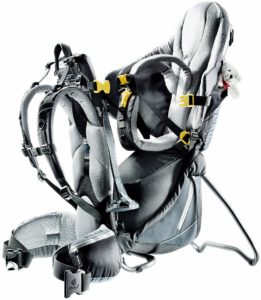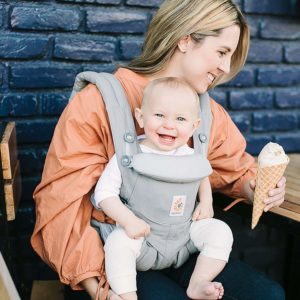So many things about becoming a parent are mysterious and uncertain…but one is not: when you have a baby, you (or somebody supporting you) will be carrying that baby around A LOT. It’s likely you’ll want some kind of baby carrier, or even a couple of different carriers as your baby grows. But which carrier is best? There are hundreds of them on the market, from simple strips of fabric and slings, to hiking backpacks with metal frames that your baby could practically camp out in.
We’ve put together this quick guide to help you sort through the dizzying array of options so you can figure out which baby carrier is going to meet your needs. Here are some basic considerations to keep in mind.
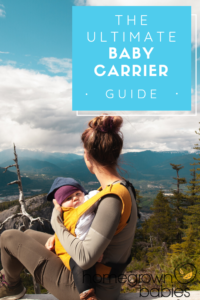
This post contains affiliate links. Income earned from these referrals allows us to keep offering free services to the community like childbirth education classes and pre/postnatal support groups. There is no additional cost to you for making purchases through our site.
- Infants and older babies need different types of carriers. Some of the “backpack style” carriers do include separate infant inserts to accomodate the needs of smaller babies. Still, in the early months (0-4), most parents prefer a simple, soft fabric carrier over a backpack. It is likely that over the course of your baby’s babyhood, you’ll want at least two different carriers.
- The most ergonomic and comfortable place to carry the weight of your baby is on your hips. Whatever carrier you get, be sure that it has a nice, broad hip-belt. It should be designed to distribute the weight of your baby onto your hips, not primarily on your shoulders (trapezius muscles). Over-the-shoulder slings can be handy for very quick trips to the store, or for occasional use around the house, but they can actually cause shoulder and neck problems if used long-term.
- Consider your climate, and the time of year you’ll be carrying your baby. The material and construction of different baby carriers can make them more warm or cooler to wear. If you live in a warmer or cooler climate, choose a baby carrier that suits your needs for warmth or ventilation. For your newborn/infant carrier, it’s likely that you’ll only be using it for 4 or 6 months. So, consider the season that your baby will be born, and choose a lighter or heavier fabric accordingly.
- Choose 100% cotton, if possible. Your baby’s skin is sensitive and porous (absorbs chemicals that it comes in contact with). Additionally, they will almost certainly end up sucking on whatever material they come in contact with. For these reasons, we recommend choosing a carrier that is 100% cotton (or any 100% natural fiber). Not only is cotton a safe, natural alternative to petroleum-based synthetic materials, but it’s also more breathable and comfortable against your skin too.
Note: even if a synthetic material is free of known toxins like pthalates and BPA, that doesn’t mean that it’s completely non toxic. Unfortunately, many new chemicals are considered safe until proven dangerous. This means that synthetic materials may contain toxins that just haven’t yet been studied and proven harmful.
- It’s great to have options when it comes to carrying positions. All babies are different, as are all parents. Most infants prefer to to be carried all snuggled up against their caregiver’s chest; but as babies grow, they get opinions and preferences about how they like to ride around. As a caregiver, you may develop preferences about how you like to carry your baby too (hopefully your preferences are the same as your baby’s!). When choosing a carrier for an older baby, it’s great to pick one that gives you lots of options such as: face to chest, face outward, backpack style, hip carry.
- If several different caregivers will use the same carrier: quick and easy adjustment is key. Some carriers are one-size-fits-all, with easy adjustments to fit snugly on any adult body. Others come in different sizes that must match the caregiver’s form. If you already know that several adults will be caring for your baby and using the same carrier, be sure to choose one that is easily adjustable.
- Especially for older babies, ask yourself how you plan to use the carrier? For newborns and infants, it’s likely that you’ll use the carrier for shorter periods of time: to get things done around the house, go for gentle walks, etc. As your baby grows you may want to go on long hikes or camping trips, or to simply carry them with you through the grocery store. The type of carrier that suits you best will depend on your specific needs. If you’re more likely to be putting on and taking off the carrier frequently (i.e. getting in and out of the car on quick errands), then a lighter, simpler carrier with less support may be just fine. On the other hand, a more substantial carrier with ample support may be a better choice if you expect to be carrying your growing baby for longer periods and on uneven terrain.
- Hand-me-downs and consignment carriers can be awesome. Often you can find gently-used carriers on Craigslist or Ebay. It’s also possible to pick them up at baby consignment shops. This can be a great and thrifty option, especially for a newborn carrier. That’s because most people only use their newborn carriers for a few months, so they sustain limited wear and tear. Backpack style carriers are sometimes used for years, and you may want to do this too. When you’re shopping for a used carrier for an older baby, be picky! Choose one that’s truly gently used. Check any velcro, toggles, and buckles to make sure that they’ll hold up.
Homegrown Picks for Baby Carriers
For newborns/infants: Our favorite style of newborn carrier is a long strip of soft fabric that can be wrapped around baby and caregiver in a variety of ways. The most familiar brand for this style is the Moby Wrap. The Moby comes in various colors and fabrics. To learn more about how to use the Moby (or any wrap-style carrier), watch this video.
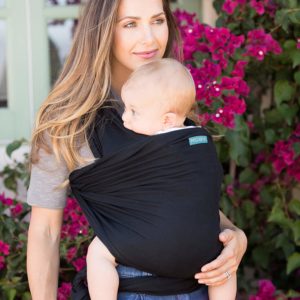
If you feel daunted with the wrapping, another option is the Baby K’tan, which is basically a pre-wrapped (and sewn into shape) wrap-style carrier that fits over the head like a t-shirt. The downside of the K’Tan is that it’s not adjustable to suit various caregivers and the changing size of your baby.
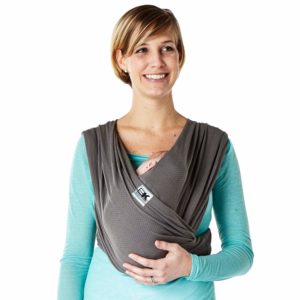
You can also choose to make your own baby wrap. Check out this video to learn how.
For older babies (4+ months): A “backpack style” pack is our pick for older babies. Two great brands are Ergobaby and LÍLLÉbaby
. Both come in 100% cotton, are easy to adjust, and offer a variety of carrying positions. An infant insert
can be purchased separately to fit the Ergo. Both the Ergo and the Líllé are comfortable for even fairly long walks. In addition, they’re quick and easy to put on and take off, so they’re great for errands and short trips too.
If you’re planning to do any serious hiking and camping, then you might consider a backpack with a rigid frame. The advantages of these are that they distribute weight more evenly onto the hips, they hold your baby slightly away from your back, for ventilation, and they generally have added features like sunshades for your little one and extra pouches to carry other gear. An overall excellent choice for a rigid-frame baby carrier is the Deuter Kid Comfort III.
